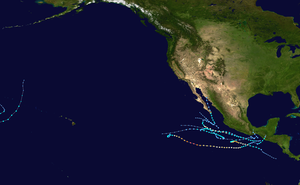| Timeline of the 2010 Pacific hurricane season | |||||
|---|---|---|---|---|---|
 Season summary map | |||||
| Season boundaries | |||||
| First system formed | May 29, 2010 | ||||
| Last system dissipated | December 21, 2010 | ||||
| Strongest system | |||||
| Name | Celia | ||||
| Maximum winds | 160 mph (260 km/h) (1-minute sustained) | ||||
| Lowest pressure | 921 mbar (hPa; 27.2 inHg) | ||||
| |||||
The 2010 Pacific hurricane season was one of the least active seasons on record, featuring the fewest named storms since 1977.[1] The season officially started on May 15 in the eastern Pacific—east of 140°W—and on June 1 in the central Pacific—between the International Date Line and 140°W—and lasted until November 30. These dates typically cover the period of each year when most tropical cyclones form in the eastern Pacific basin.[2] The season's first storm, Tropical Storm Agatha, developed on May 29; the season's final storm, Tropical Storm Omeka, degenerated on December 21.
The season began with record-breaking activity with four named storms, including two major hurricanes, developing by the end of June.[1] Accumulated cyclone energy (ACE)[nb 1] values exceeded 300 percent of the average for the month of June.[3] Activity abruptly diminished thereafter, with July, August, and September seeing record low storm development. The Eastern Pacific season proper ended with Tropical Storm Georgette's dissipation on September 23, a month before the climatological mean.[1] The year's final cyclone, Omeka, developed in the off-season on December 18, marking a record-late formation date in the satellite-era.[4] Although there were relatively few storms, the season proved exceptionally deadly and destructive. Torrential rains associated with Agatha and Eleven-E killed well over 200 people in Central America and Mexico and left more than $1.5 billion in damage.[5][6]
Four time zones are utilized in the basin: Central for storms east of 106°W, Mountain between 114.9°W and 106°W, Pacific between 140°W and 115°W,[7] and Hawaii–Aleutian for storms between the International Date Line and 140°W. However, for convenience, all information is listed by Coordinated Universal Time (UTC) first with the respective local time included in parentheses. This timeline includes information that was not operationally released, meaning that data from post-storm reviews by the National Hurricane Center, such as the subtropical phase of Omeka, is included. This timeline documents tropical cyclone formations, strengthening, weakening, landfalls, extratropical transitions, and dissipations during the season.
- ^ a b c Stacy R. Stewart and John P. Cangialosi (September 2012). "Eastern North Pacific Hurricane Season of 2010". Monthly Weather Review. 140 (9). American Meteorological Society: 2, 769–2, 781. Bibcode:2012MWRv..140.2769S. doi:10.1175/MWR-D-11-00152.1.
- ^ Christopher W. Landsea; Neal Dorst; Erica Rule (June 2, 2011). "G: Tropical Cyclone Climatology". Hurricane Research Division: Frequently Asked Questions. National Oceanic and Atmospheric Administration. G1) When is hurricane season ?. Retrieved June 22, 2015.
{{cite book}}:|work=ignored (help) - ^ Eric S. Blake (July 1, 2010). Eastern Pacific Monthly Tropical Weather Summary for June 2010. National Hurricane Center (Report). Miami, Florida: National Oceanic and Atmospheric Administration. Retrieved June 28, 2010.
- ^ Timothy A. Craig and Samuel Houston (March 8, 2011). Tropical Cyclone Report: Tropical Storm Omeka. Central Pacific Hurricane Center (Report). Honolulu, Hawaii: National Oceanic and Atmospheric Administration. Retrieved June 27, 2015.
- ^ Cite error: The named reference
Agathawas invoked but never defined (see the help page). - ^ "International Disaster Database: Disaster List". Centre for Research on the Epidemiology of Disasters. 2015. Archived from the original on July 8, 2015. Retrieved June 28, 2015.
- ^ Robbie Berg (May 28, 2015). Tropical Depression One-E Discussion Number 1. National Hurricane Center (Report). Miami, Florida: National Oceanic and Atmospheric Administration. Retrieved June 27, 2015.
Cite error: There are <ref group=nb> tags on this page, but the references will not show without a {{reflist|group=nb}} template (see the help page).
